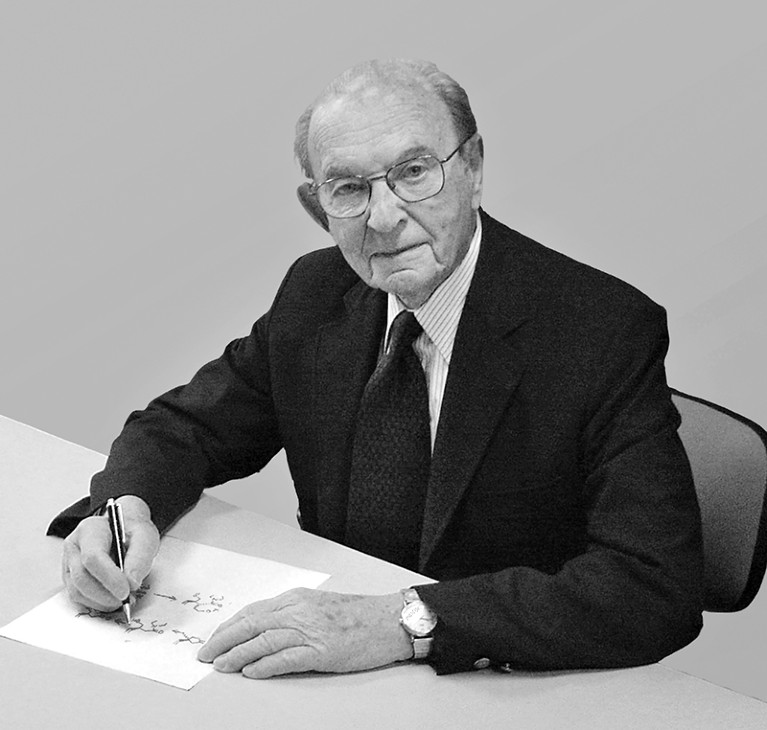
Gilbert StorkCredit: Courtesy Stork family
Gilbert Stork was a master molecule maker, an inspiring mentor and educator, and one of the most charming, graceful and witty persons one could hope to meet. He pioneered the transition of organic synthesis from a largely empirical endeavour to one guided by design. He introduced new methods, reagents and strategies for the selective construction of organic molecules, and found new ways to think about bond formation. He contributed to our understanding of how nature makes certain classes of natural product, providing a foundation for the field of biomimetic synthesis.
Stork, a professor emeritus at Columbia University in New York, died on 21 October at the age of 95. He was born in Belgium on 31 December 1921 in a suburb of Brussels called Ixelles, and grew up in Paris and Nice. From his early schooling, he remembered “only two classes, French and Chemistry”, the latter “taught by a very good teacher”, he noted in a 2011 autobiographical paper (G. Stork Tetrahedron 67, 9754–9764; 2011). In 1939, with the Second World War looming, his family moved to the United States.
What followed were a series of fortunate accidents that defined much of his future. He set out by bus to begin his undergraduate education at the University of North Carolina at Chapel Hill, only to realize on arrival that he “had to apply for admission”. He got back on the bus and headed to Florida, where he enrolled at the University of Florida in Gainesville (and where he met his future first wife, Winifred Stewart).
Majoring in chemistry, he happened upon a report noting that some chemists were trying to synthesize quinine, a complex natural agent used to treat malaria. He wrote that he “found this fantastic, and quinine remained a goal for the rest of my life”.
He later set out for graduate work at the University of Illinois at Urbana–Champaign, but was again thwarted by not having applied for admission. He ended up pursuing his PhD with Samuel McElvain at the University of Wisconsin–Madison, where he befriended Carl Djerassi and William (Bill) Johnson, who were to figure prominently in his career. Continuing his opportunistic ways, Stork recruited another graduate student to work with him while still a graduate student himself. After receiving his doctorate in 1945, he spent a year as a research chemist (and was technically an ‘illegal alien’) at Lakeside Laboratories in Milwaukee, Wisconsin. Working in his own time during evenings at the lab, he conducted research that figured in a new way of synthesizing steroids.
He started work at Harvard University in Cambridge, Massachusetts, in 1946. There, Stork became a seminal figure in the emergence of stereocontrolled synthesis, the science of precisely connecting molecular fragments into distinct 3D arrays. In partnership with one of his students, Albert Burgstahler, he performed one of the earliest examples of the stereocontrolled synthesis of a natural product — the compound cantharidin. This set the standard for future work in the field.
Also during this time, Stork proposed a cascading set of reactions that converted long linear molecules into products that have many molecular rings (polycycles), later called the Stork–Eschenmoser hypothesis. This provided the conceptual basis for biomimetic synthesis, and for work by Johnson and others on making polycycles, including human hormones and many therapeutic agents.
In 1953, Stork joined the faculty at Columbia University. There he published his first studies on enamine alkylations, a general way to make carbon–carbon bonds. This served as a foundation for synthesis techniques using certain metal-containing reactive species (called metallo-enamines), and for the selective generation of compounds called ketone enolates, highly useful intermediates for bond formation. Later, he pioneered the use of yet other reactive intermediates for building complex molecules, including free-radical-based methods for carbon–carbon bond formation.
Stork was fascinated by reaction mechanisms and intermediates, and had an uncanny ability to see that special bond or arrangement of atoms in a complex target that was a key to its construction. Make that bond, and the molecule would almost seem to self-assemble.
He chose his targets well, picking molecules that both posed synthetic challenges and had interesting biological activity. Over the years, he targeted and made sex hormones, steroids, hormone-like prostaglandins and anticancer agents. Some 60 years after setting his sights on the compound, in 2001 he and his co-workers published the first stereoselective total synthesis of quinine (G. Stork et al. J. Am. Chem. Soc. 123, 3239–3242; 2001).
His last paper, published just weeks before his death, reported studies towards the synthesis of an agent called germine, which can be used to control blood pressure — a compound that at least 15 students had worked on between 1979 and 2000 (G. Stork et al. Org. Lett. 19, 5150–5153; 2017). In 2010, Gilbert and his second wife, Ayako Yamashita, declared that finishing this synthesis would be a good retirement project. According to a colleague at Columbia, the two completed it “as a labor of love — a gift to each other and to all of Professor Stork’s students”.
Stork’s mastery inspired his co-workers and all who followed in his steps. One of his most enduring contributions is his influence on many generations of chemists and how they think about synthesis. Stork was a wonderful scientist and a wonderful person, motivated by his love of chemistry and by a desire to help others.

 George Andrew Olah (1927–2017)
George Andrew Olah (1927–2017)
 Organic synthesis: The robo-chemist
Organic synthesis: The robo-chemist
 Chemistry: Why synthesize?
Chemistry: Why synthesize?








